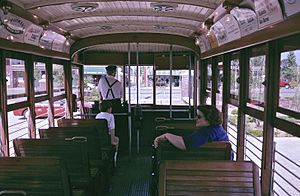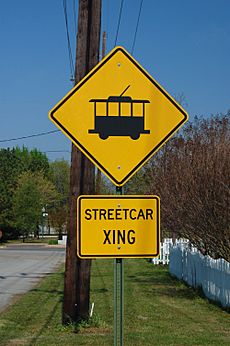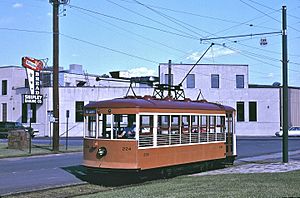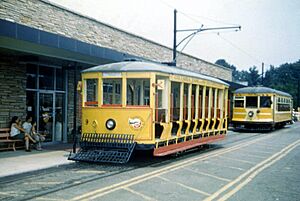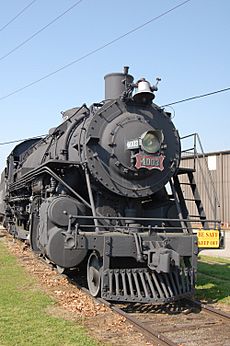Fort Smith Trolley Museum facts for kids
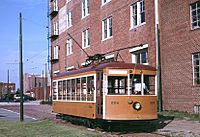
1926 Birney streetcar 224 passing the
Fort Smith Museum of History |
|
| Established | 1985 |
|---|---|
| Location | 100 South 4th Street, Fort Smith, Arkansas, U.S. |
| Type | Railroad, streetcar |
| Owner | Fort Smith Streetcar Restoration Association, Inc. |
The Fort Smith Trolley Museum is a fun place in Fort Smith, Arkansas. It's a museum about streetcars and trains. You can even ride an old-fashioned heritage streetcar there! The museum first opened its doors in 1985. The streetcar rides started a few years later, in 1991.
Some of the vehicles at the museum are very special. Four of them, including a streetcar and three steam trains, are listed on the National Register of Historic Places (NRHP). This means they are important historical items. The streetcar line is about 0.75 miles (1.2 kilometers) long. It also passes by four other historic places listed on the NRHP. These include the Fort Smith National Historic Site and the Fort Smith National Cemetery.
Contents
History of the Museum
The museum was started by a group called the Fort Smith Streetcar Restoration Association (FSSRA). They formed in 1979. Their goal was to save and show off the history of public transportation in Fort Smith. The first museum building was built in 1985. It was on land that used to belong to a railroad company. Over the years, the museum bought more land. This allowed them to grow and store more items.
You might wonder why the group is called "Streetcar" but the museum is called "Trolley." In America, people often use both words to mean the same thing. The Fort Smith Trolley Museum (FSTM) welcomed its first visitors in 1985. The streetcar rides began in 1991. The FSSRA still owns and runs the museum today.
Riding the Streetcar Line
The streetcar rides at the museum officially started on May 19, 1991. The first streetcar used was Fort Smith car 224. This was a Birney-type streetcar built in 1926. It was made by the American Car Company. In its first seven months, over 10,000 people enjoyed rides on the streetcar!
The first part of the line was about a quarter-mile long. It used old freight tracks. Volunteers from the FSSRA put up the trolley wires and poles. This first section connected the streetcar barn to the Fort Smith National Historic Site.
The streetcar line has been made longer several times since then. The first extension opened on October 9, 1994. It took the line to the gates of the Fort Smith National Cemetery. This extension more than doubled the track length. It made the line about 2,300 feet (700 meters) long. Almost 12,000 passengers rode the trolley in 1994.
Another extension opened on August 29, 1996. This one went to Garrison Avenue, which is the main street in town. This short extension crossed Rogers Avenue. The city helped pay for the crossing. They knew the streetcar line was important for attracting tourists. This part of the line goes behind the Fort Smith Museum of History. The museum is in a historic building called the Atkinson-Williams Warehouse.
The line was extended again on November 24, 2002. It ran along the south side of Garrison Avenue to 2nd Street. This area is part of the West Garrison Avenue Historic District, which is also a historic place. In May 2005, a very short extension took the track across Wheeler Avenue to 7th Street. This made the line about 3,000 feet (910 meters) long.
The most recent extension opened on May 21, 2016. It added new track and wires along 7th Street. The line's new end point is on 7th Street at Rogers Avenue. This extension was about 750 feet long. It made the entire streetcar line about 0.75 miles (1.2 kilometers) long.
Streetcar Schedule
You can ride the streetcar almost all year! From May 1 through October 31, it runs seven days a week. During the other months, it runs on weekends. On Saturdays and weekdays (when operating), the hours are 10:00 AM to 5:00 PM. On Sundays, it runs from 1:00 PM to 5:00 PM. A special ramp for wheelchairs was built at one stop in 1997.
Museum Vehicles
The museum has many interesting vehicles. These include streetcars, trains, and even old buses.
Streetcars
As of 2016, the museum has two streetcars that are fully restored and ready to operate. One is Fort Smith car 224. It was built in 1926 and is listed on the National Register of Historic Places. The other is Hot Springs Street Railway Company car 50. This car was built in 1904 and ran in Hot Springs, Arkansas, until 1939.
Car 50 started running in May 2016, after 16 years of hard work to restore it. However, Birney car 224 is still the main streetcar used for regular rides. This is because it's easier for one person to operate. Many Birney cars like 224 were used in Fort Smith until the original streetcar system closed down on November 15, 1933.
For the first 25 years of streetcar rides at the museum, car 224 was the only one working. That changed when car 50 was finished in 2016.
The museum has other streetcars that used to run in Fort Smith:
- Fort Smith Traction, Light and Power 10 (built in 1902, only the body remains)
- Fort Smith Light and Traction 205 (a Birney car from 1919, only the body remains)
- Fort Smith Light and Traction 221 (a Birney car from 1926, only the body remains)
In 1995, the museum also got an open streetcar from Mexico. It was built in 1908. Another Birney car in the collection is ex-Kansas City 1545, built in 1919.
In 2009, three more streetcars joined the collection. These included two Birney cars from Little Rock, Arkansas. The museum plans to combine parts from these two cars to make one working car. They also got a second open car from Veracruz, Mexico, car 9. This car is similar to their other Veracruz car, car 6. The museum now plans to restore car 9 first, using some parts from car 6.
Locomotives (Trains)
The museum has four locomotives (train engines) on display. Three of them are listed on the National Register of Historic Places (NRHP) because they are so important:
- Frisco 4003: This is a large steam locomotive built in 1919. It was given to the museum in 1998 and added to the NRHP in 2004.
- Maumelle Ordnance Works Locomotive 1: This is a 35-ton switcher train built in 1942. It was donated in 1988 and listed on the NRHP in 2006.
- United States Air Force Locomotive No. 1246: This is a 44-ton diesel-electric switcher train built in 1953. It was added to the NRHP on the same day as Locomotive No. 1, in 2006. The museum got it in 1992.
The museum also has three cabooses (the last car on a freight train), a passenger car, and other types of railroad cars.
Buses
In 1997, the museum owned three old motor buses:
- A 1939 Twin Coach R-23 bus from Little Rock.
- A 1954 General Motors bus (model TGH-3102) that used to run in Fort Smith.
- A 1951 General Motors bus from Oklahoma City.
The original Fort Smith bus, No. 285, was even used in the 1988 movie Biloxi Blues.
See also
- Fort Smith Transit
- Streetcars in North America


